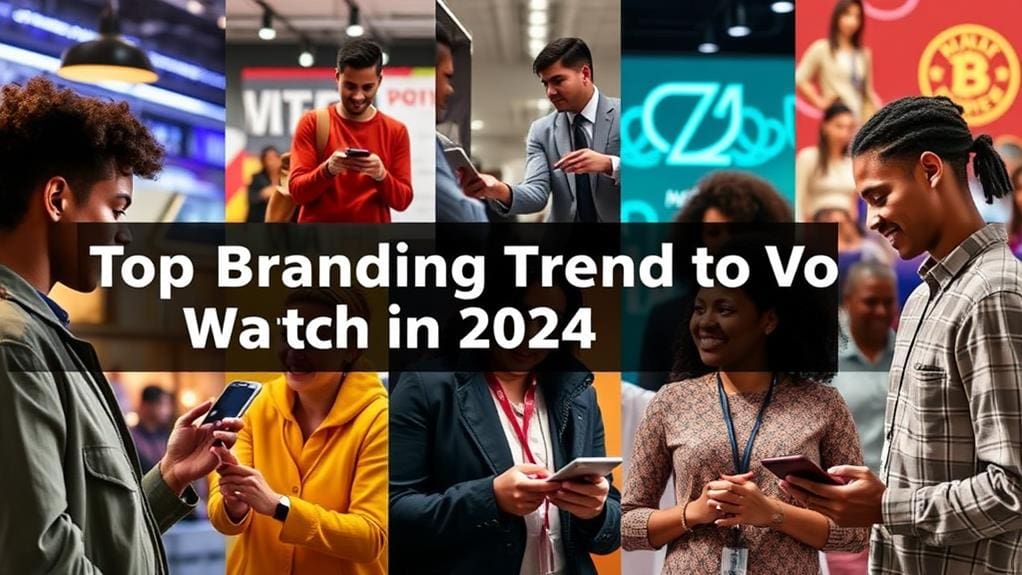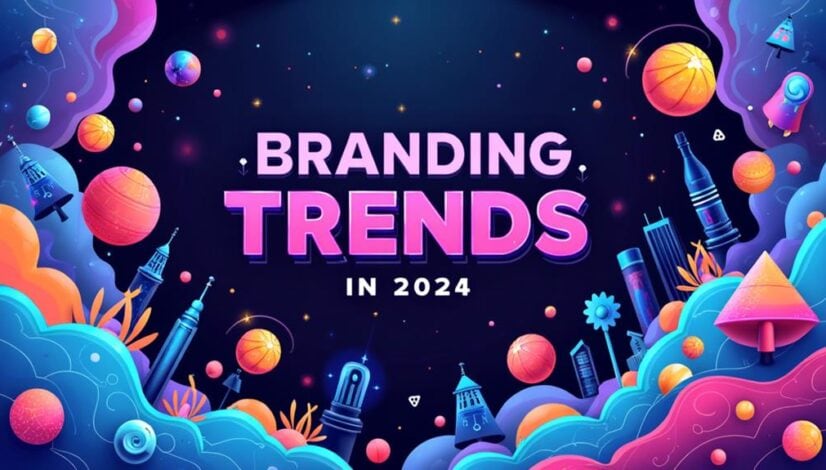Top Branding Trends to Watch in 2024
In 2024, branding trends will pivot towards sustainability, authentic storytelling, and enhanced personalization. Consumers increasingly demand eco-friendly practices and transparency, compelling brands to align their missions with social causes. Emotional connections will flourish through relatable narratives and diverse perspectives, reinforcing brand loyalty. Technological advancements, like augmented reality and data analytics, will drive tailored consumer experiences. Voice search optimization will reshape communication strategies, while minimalist aesthetics will promote clarity and simplicity. These trends signify a transformative shift in branding strategies, highlighting the necessity for brands to adapt and innovate in a competitive landscape. Uncover more insights on these developments.
Key Takeaways
- Sustainability and purpose-driven marketing are crucial as consumers increasingly demand eco-friendly practices and brands aligned with their values.
- Authentic storytelling fosters emotional connections, enhancing brand loyalty through relatable and compelling narratives across various platforms.
- Transparency and trust are vital, with brands expected to disclose their practices and supply chain details to build consumer confidence.
- Personalization and inclusivity drive unique experiences, as brands leverage data analytics to tailor offerings and reflect audience diversity.
- Community-centric branding strengthens local connections through hyperlocal marketing and participation in local events, enhancing trust and loyalty.
Sustainability as a Core Value

Embracing sustainability as a core value is increasingly becoming a strategic imperative for brands aiming to resonate with conscious consumers in 2024. The shift toward eco-friendly practices is not merely a trend but a necessary evolution in brand identity that reflects a growing consumer demand for responsible consumption.
This evolution is underscored by the rising awareness of environmental issues, prompting brands to adopt innovative solutions that integrate sustainability into their operations.
Central to this transformation is the adoption of eco-friendly packaging, which serves as a tangible representation of a brand's commitment to environmental stewardship. By utilizing renewable materials, brands can greatly reduce their carbon footprint while appealing to environmentally conscious consumers.
These materials, derived from sustainable sources, not only minimize the depletion of finite resources but also enhance the brand's image as a forward-thinking entity.
Moreover, the strategic choice of eco-friendly packaging can foster deeper engagement with consumers who prioritize sustainability in their purchasing decisions.
Brands that transparently communicate their use of renewable materials can effectively differentiate themselves in a crowded market, creating a loyal customer base that values ethical practices.
Authentic Storytelling Techniques
As brands navigate the complexities of consumer expectations in 2024, authentic storytelling techniques emerge as essential tools for fostering meaningful connections.
Personal narratives not only humanize brands but also enhance transparency, cultivating trust in an increasingly skeptical marketplace.
Personal Narratives in Marketing
Four key elements define the effectiveness of personal narratives in marketing: authenticity, relatability, emotional resonance, and clarity. These elements serve as the backbone for a compelling brand identity, enabling marketers to craft stories that resonate deeply with audiences. Authenticity fosters trust, while relatability guarantees that the narrative connects with the consumer's own experiences, enhancing emotional resonance.
To achieve narrative consistency, brands must maintain a coherent message across various platforms, reinforcing their personal branding efforts. Utilizing story arcs effectively allows marketers to engage audiences through structured narratives that unfold over time, creating anticipation and investment in the brand's journey.
Visual storytelling complements these narratives by providing a sensory experience that amplifies emotional engagement. Through imagery and design, brands can evoke feelings that align with their core message, further embedding their authenticity in the consumer's mind.
As 2024 approaches, the integration of personal narratives in marketing will not only enhance audience engagement but also solidify brand authenticity, setting a standard for deeper connections in the marketplace.
Embracing these storytelling techniques will be essential for brands aiming to thrive in an increasingly competitive landscape.
Transparency and Brand Trust
During a time when consumers increasingly demand authenticity from brands, transparency has emerged as a pivotal factor in building trust. The rise of consumer empowerment has shifted the power dynamics, necessitating that brands adopt a more accountable approach in their operations.
Authentic storytelling techniques become essential in this landscape, as they not only communicate brand values but also foster an emotional connection with the audience. Brands are now expected to disclose their practices, sourcing, and supply chain details. This level of openness creates an environment where consumers feel informed, valued, and respected.
By sharing genuine narratives about their journeys—both successes and challenges—brands can demonstrate brand accountability, reinforcing their commitment to ethical practices. Moreover, transparency in communication can mitigate skepticism that often surrounds marketing claims.
When consumers perceive a brand as sincere, they are more likely to establish loyalty and advocate for it within their networks. As we move into 2024, brands that master the art of authentic storytelling, while emphasizing transparency, will not only enhance their reputation but also cultivate an enduring relationship with their empowered consumers.
This shift is not merely a trend; it is a fundamental evolution in the branding landscape.
Emotional Connection Strategies
Authenticity serves as a cornerstone for emotional connection strategies in branding, particularly through authentic storytelling techniques. In a time when consumers are inundated with information, emotional branding emerges as a crucial differentiator, allowing brands to forge deeper connections with their audiences. Through compelling narratives that resonate on a personal level, brands can evoke consumer empathy, transforming transactional relationships into meaningful engagements.
Effective storytelling goes beyond mere marketing; it taps into shared experiences and values, creating a sense of belonging. Brands that articulate their origins, challenges, and triumphs foster an environment where consumers feel understood and valued. This approach not only enhances brand loyalty but also encourages advocacy, as consumers are more inclined to share stories that reflect their own identities.
Furthermore, leveraging diverse perspectives within storytelling enriches the brand narrative, ensuring that it resonates with a broader audience.
As emotional connection strategies evolve, brands must remain vigilant in constructing narratives that are not only authentic but also adaptive to changing consumer landscapes. By doing so, they can cultivate lasting relationships that transcend traditional marketing paradigms, ultimately positioning themselves for sustained success in an increasingly competitive marketplace.
Rise of Personalization

As consumers increasingly seek unique experiences tailored to their individual preferences, the rise of personalization in branding has emerged as a defining trend for 2024. This shift signifies a profound transformation in how brands engage with their audiences, moving from one-size-fits-all approaches to meticulously crafted interactions that resonate on a personal level.
Central to this evolution is the demand for customized experiences. Brands that harness data analytics and artificial intelligence can curate offerings that align closely with consumer desires. This not only enhances customer satisfaction but also fosters loyalty, as individuals feel a deeper connection to brands that recognize their unique tastes and behaviors.
For instance, e-commerce platforms are leveraging machine learning algorithms to recommend products based on previous purchases and browsing history, creating seamless shopping experiences that feel bespoke.
Moreover, targeted messaging plays an essential role in the personalization paradigm. Brands are increasingly employing sophisticated segmentation strategies to deliver content that speaks directly to specific audience segments.
Embracing Diversity and Inclusion
The increasing emphasis on personalization in branding naturally paves the way for a broader conversation about diversity and inclusion. As consumers increasingly seek brands that reflect their values and identities, the call for cultural representation becomes essential. Brands must recognize that their audiences are not monolithic; they are a tapestry of diverse backgrounds, experiences, and perspectives. This recognition necessitates a shift from traditional marketing strategies to more nuanced approaches that embrace inclusive messaging.
Inclusive messaging serves as a powerful tool in establishing brand loyalty and authenticity. By thoughtfully integrating diverse voices and stories into their narratives, brands can foster a deeper emotional connection with their audience. This connection is particularly crucial in today's competitive landscape, where consumers are more discerning about the companies they support. Brands that prioritize diversity in their messaging do not merely enhance their image; they actively contribute to a culture of equity and respect.
Furthermore, brands must guarantee that their commitment to diversity extends beyond marketing rhetoric. This includes reflecting diversity in hiring practices, product development, and community engagement. By embedding inclusivity into the core of their operations, brands can create a holistic approach that resonates with consumers on multiple levels.
In 2024, the successful brand will be one that not only recognizes the importance of diversity and inclusion but also actively champions it. By doing so, they will not only meet consumer expectations but also position themselves as leaders in fostering a more equitable marketplace.
Leveraging Augmented Reality

In an increasingly digital landscape, brands are harnessing the transformative power of augmented reality (AR) to engage consumers in innovative ways. By integrating AR into their marketing strategies, companies can create immersive experiences that not only captivate audiences but also foster deeper connections through virtual interactions.
The potential of AR lies in its ability to enhance consumer engagement through various applications. Brands can leverage AR in several impactful ways:
- Product Visualization: Allowing consumers to visualize products in their own environment before purchase, thereby reducing uncertainty and improving conversion rates.
- Interactive Advertising: Creating engaging advertisements that invite consumers to interact, transforming traditional ads into dynamic experiences that encourage participation.
- Gamification: Incorporating game-like elements into marketing campaigns, enticing customers to engage with the brand on a deeper level while enjoying a fun, interactive experience.
As brands continue to explore the vast possibilities of AR, the emphasis on providing immersive experiences will be paramount. This technology not only enhances the consumer journey but also allows brands to collect valuable data on user preferences and behaviors, enabling more personalized marketing strategies.
Community-Centric Branding
As brands increasingly prioritize community-centric strategies, the emphasis on building local connections becomes paramount.
This approach not only fosters trust but also enables brands to harness authentic storytelling that resonates with their target audience.
Building Local Connections
Frequently, brands that prioritize community-centric strategies find themselves forging deeper connections with their local audiences. During a time when consumers increasingly seek authenticity and relatability, building local connections is paramount.
Successful brands leverage hyperlocal marketing and foster local loyalty by engaging in meaningful neighborhood involvement.
To effectively cultivate these connections, consider the following strategies:
- Local Partnerships: Collaborate with nearby businesses to create a synergistic effect, enhancing visibility and credibility within the community.
- Community Events: Actively participate in or sponsor local events, showcasing commitment to grassroots initiatives and strengthening ties with residents.
- Regional Collaborations: Engage in cross-promotional efforts with local organizations, fostering a sense of unity and shared purpose that resonates with the community.
These initiatives not only enhance brand visibility but also create a sense of belonging among consumers.
By investing in community sponsorships and prioritizing genuine interactions, brands can develop trust and loyalty that transcends traditional marketing efforts.
Ultimately, effective community-centric branding transforms local connections into enduring relationships, positioning brands as integral parts of the local fabric.
Engaging Authentic Storytelling
Engaging authentic storytelling serves as a powerful tool for brands aiming to resonate deeply with their communities. By leveraging visual storytelling and narrative authenticity, brands can create compelling narratives that foster emotional resonance. This approach not only builds trust but also enhances consumer engagement through shared cultural narratives that reflect the community's values and experiences.
Incorporating various storytelling mediums—such as video, social media, and interactive content—allows brands to craft immersive experiences that captivate audiences. These experiences should align with the brand voice, ensuring consistency while still adapting to the nuances of the community's identity.
Brands can also develop their own mythology, weaving together elements of history and contemporary relevance to create a cohesive storytelling framework. This mythology serves as a foundation for ongoing dialogue, inviting consumers to become active participants in the brand's journey.
Moreover, by understanding the cultural narratives that shape their target audience, brands can tailor their stories to resonate on a deeper level. In 2024, the emphasis on engaging authentic storytelling will be paramount, enabling brands to forge lasting connections and foster community-centric loyalty.
Data-Driven Decision Making

Harnessing the power of data analytics, brands are increasingly turning to data-driven decision making as a cornerstone of their strategic frameworks. In an era defined by rapid shifts in consumer behavior, leveraging data not only enhances market segmentation but also enables brands to tap into predictive modeling that anticipates future trends.
This approach allows organizations to gain profound customer insights, guaranteeing they remain relevant and competitive.
To effectively implement data-driven strategies, brands should focus on the following three key areas:
- Performance Metrics: Establishing clear performance metrics allows brands to measure the effectiveness of their strategies and make informed adjustments. This guarantees that marketing efforts are aligned with business objectives.
- Behavioral Trends: By analyzing behavioral trends through data visualization, brands can identify patterns that inform product development and marketing approaches, ultimately enhancing customer engagement.
- A/B Testing and Demographic Analysis: Employing A/B testing alongside demographic analysis empowers brands to refine their messaging. This iterative process not only optimizes campaigns but also fosters deeper connections with targeted audiences.
Incorporating these elements into a cohesive data-driven strategy fosters trend forecasting that anticipates shifts in the market landscape.
As brands continue to navigate an increasingly complex environment, the ability to derive actionable insights from data analytics will be paramount. The future belongs to those who can not only gather data but translate it into strategic advantages that resonate with their audiences.
Voice Search Optimization
As voice search continues to reshape consumer behavior, the integration of conversational keywords into branding strategies becomes essential.
This shift not only enhances user engagement but also necessitates a keen focus on optimizing for local searches, enabling brands to connect more effectively with their target audiences.
Understanding these dynamics will be vital for marketers aiming to stay ahead in the evolving digital landscape of 2024.
Importance of Conversational Keywords
The rise of voice-activated devices has transformed the landscape of search engine optimization, making conversational keywords a central focus for brands aiming to enhance their online visibility.
As consumers increasingly rely on voice search for information, the need for a conversational tone becomes paramount. This shift demands a re-evaluation of traditional keyword strategies in favor of more natural language that mirrors everyday speech.
To effectively harness the power of conversational keywords, brands should consider the following strategies:
- Keyword Integration: Seamlessly incorporate long-tail keywords that reflect common questions or phrases people use when speaking.
- Content Adaptation: Develop content that answers potential voice search queries, ensuring clarity and conciseness.
- User Intent Understanding: Analyze search intent behind voice queries to create content that resonates with users' needs and expectations.
Optimizing for Local Searches
Local searches have become a vital focus for brands seeking to connect with consumers in their immediate vicinity, particularly in the era of voice search optimization.
As voice-activated technology proliferates, optimizing for local SEO is essential for brands aiming to capture attention with geographic targeting. This approach relies heavily on mobile optimization, as users increasingly conduct searches while on the move.
Effective local search strategies demand tailored, localized content that resonates with community engagement. Brands must identify regional keywords that reflect the local vernacular and search intent, ensuring their offerings align with consumer needs.
Additionally, maintaining accurate map listings is important for visibility, as these can greatly influence foot traffic and online interactions.
Customer reviews also play a pivotal role in local search rankings, serving as social proof that enhances credibility and trust. By encouraging and managing customer feedback, brands can bolster their online presence and influence search outcomes.
Ultimately, a thorough voice search optimization strategy that incorporates these elements will not only elevate a brand's visibility but also foster a deeper connection with the local community, paving the way for sustained growth in an increasingly competitive landscape.
Minimalist Brand Aesthetics

In recent years, a significant shift towards minimalist brand aesthetics has emerged, reflecting a broader cultural movement prioritizing simplicity and clarity. This trend encapsulates the desire for visual simplicity, allowing brands to communicate their core messages without unnecessary distractions. Companies are increasingly adopting clean lines, muted palettes, and effective use of negative space to create a cohesive visual identity.
Minimalist brand aesthetics can be broken down into three key characteristics:
- Typography Choices: The selection of typefaces that are straightforward and legible reinforces brand consistency and enhances the overall aesthetic. Brands often favor sans-serif fonts that convey modernity and clarity.
- Logo Evolution: Many brands are re-evaluating their logos, stripping away extraneous elements to focus on essential features. This evolution not only modernizes their image but also guarantees that logos remain versatile across various applications.
- Minimalist Packaging: With sustainability in mind, brands are opting for minimalist packaging designs that reduce waste while maintaining an elegant appearance. This approach not only appeals to environmentally conscious consumers but also emphasizes product quality through simplicity.
As brands navigate this minimalist landscape, they must balance the principles of clean design with the need for differentiation.
Purpose-Driven Marketing Strategies
As consumers increasingly seek brands that align with their values, purpose-driven marketing strategies have emerged as a pivotal approach for companies looking to establish deeper connections with their audiences. This trend reflects a broader cultural shift towards social impact and ethical branding, where consumers prioritize their purchasing decisions based on a brand's commitment to societal issues.
At the core of purpose-driven marketing lies mission alignment, which requires brands to clearly articulate their purpose and integrate it into their overall strategy. This alignment fosters authenticity, enabling companies to engage in brand activism that resonates with consumers who demand transparency and accountability.
By championing causes relevant to their target demographics, brands enhance community engagement and foster a sense of belonging among consumers.
Moreover, values-driven marketing empowers consumers, allowing them to feel part of a larger movement. This empowerment not only cultivates brand loyalty but also transforms customers into brand advocates who actively promote the brand's initiatives.
Successful brands leverage this dynamic by creating immersive experiences that showcase their commitment to social issues, thereby deepening emotional connections.
In 2024 and beyond, purpose-driven marketing will continue to redefine the landscape of consumer-brand relationships. Companies that effectively harness these strategies will not only drive sales but also contribute positively to society, positioning themselves as leaders in ethical branding.
This transformative approach ultimately transcends traditional marketing tactics, creating a more sustainable and impactful business model that resonates with the values of today's conscientious consumers.
Frequently Asked Questions
How Do Brands Measure the Success of Sustainability Initiatives?
Brands measure the success of sustainability initiatives through rigorous impact assessment and metric development.
By establishing clear, quantifiable goals, organizations can evaluate environmental, social, and economic outcomes.
Key performance indicators (KPIs) such as carbon footprint reduction, waste diversion rates, and community engagement levels provide insights into effectiveness.
Additionally, stakeholder feedback and transparent reporting enhance accountability, enabling brands to refine their strategies and demonstrate genuine commitment to sustainability.
Ultimately, this fosters consumer trust and loyalty.
What Tools Can Help With Personalized Marketing Efforts?
In a world where brands endeavor to cultivate meaningful connections, leveraging advanced tools becomes paramount. Data analytics facilitate nuanced customer segmentation, allowing brands to tailor their messaging effectively.
Additionally, AI personalization elevates marketing strategies by creating bespoke experiences for each consumer. Behavioral tracking further enriches this approach, providing insights into preferences and habits.
Collectively, these tools empower brands to forge deeper relationships with their audience, enhancing engagement and loyalty in an increasingly competitive landscape.
What Are Effective Ways to Tell a Brand's Story?
Effective brand storytelling hinges on the art of visual storytelling, which engages audiences through compelling imagery and design.
Establishing an emotional connection is essential, as it fosters loyalty and trust. Authentic messaging reinforces the brand narrative, ensuring consistency and relatability.
How Can Brands Ensure Diversity in Their Marketing Campaigns?
To cultivate a culture of inclusivity, brands must prioritize authentic representation in their marketing campaigns.
This involves embracing diverse demographics and delivering inclusive messaging that resonates with varied audiences. By showcasing multifaceted narratives and reflecting real-life experiences, brands can foster deeper connections with consumers.
Additionally, conducting thorough market research and collaborating with diverse creators will enhance credibility and guarantee that all voices are represented, ultimately driving brand loyalty and engagement.
What Role Does Customer Feedback Play in Brand Decision-Making?
Customer feedback plays a pivotal role in brand decision-making by providing invaluable customer insights that inform strategy.
Establishing robust feedback loops allows brands to continuously gather and analyze consumer opinions, preferences, and pain points. This iterative process not only enhances product development and marketing efficacy but also fosters customer loyalty by demonstrating responsiveness.
Ultimately, integrating customer feedback into decision-making processes empowers brands to align more closely with market demands, driving sustained growth and competitive advantage.
Conclusion
As the branding landscape evolves, these trends serve as guiding stars, illuminating the path toward deeper consumer connections. Sustainability, authenticity, and personalization intertwine like threads in a tapestry, creating a rich narrative that resonates. Embracing diversity and leveraging technology such as augmented reality paint a vibrant picture of inclusivity and innovation. In this dynamic environment, brands must navigate with purpose-driven strategies, crafting a compelling mosaic that captures the essence of contemporary consumer values and aspirations.




